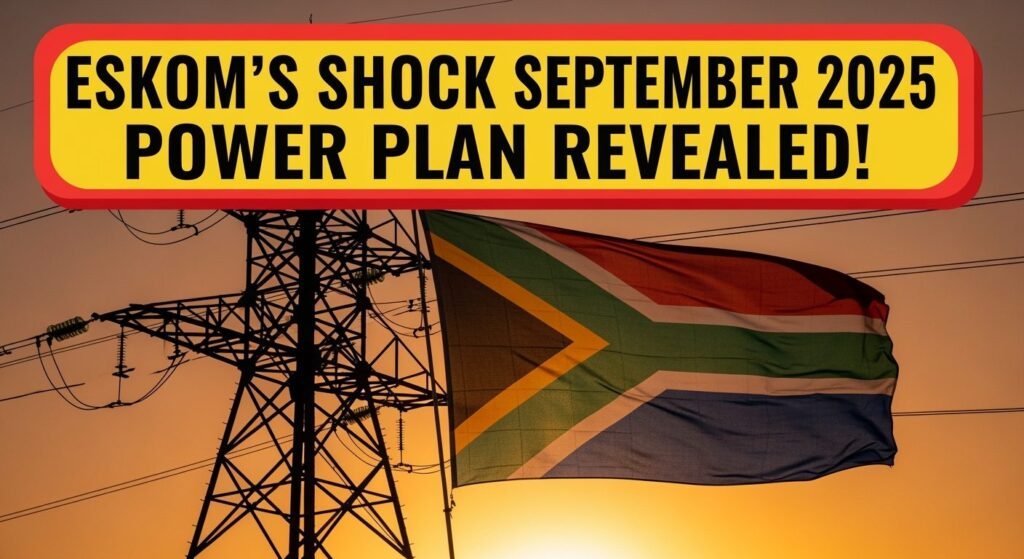Eskom Load Shedding Plan: I’ve just reviewed the comprehensive area-wise breakdown of Eskom’s September Load Shedding 2025 Plan that was published today, and I wanted to share the details with you immediately. This new schedule affects millions of South Africans across different municipalities and introduces significant changes to how power outages will be managed. Have you been wondering how your area might be impacted by these new developments? The newly released plan outlines specific time slots and frequency of outages for each region, with some areas seeing improvements while others may experience more frequent interruptions.

What Does Eskom’s New Load Shedding Schedule Include?
The newly published Eskom’s September Load Shedding 2025 Plan provides a detailed breakdown of how power interruptions will be distributed across different areas. The schedule is organized by municipalities and further subdivided into zones, with each zone assigned to specific stages and time slots. I noticed that the plan introduces a more equitable distribution system that aims to minimize the economic impact on industrial areas while ensuring residential areas don’t bear a disproportionate burden. The document also outlines contingency measures for critical infrastructure such as hospitals, water treatment facilities, and public safety installations, which will receive priority during severe outage periods.
Additionally, the plan introduces a new color-coded system that allows residents to quickly identify their area’s load shedding status through Eskom’s mobile app and website. This represents a significant improvement in communication transparency compared to previous years’ schedules.
 South Africa Weekend Weather September 2025 – Authorities Warn of Intense Rainfall This Week
South Africa Weekend Weather September 2025 – Authorities Warn of Intense Rainfall This Week
Why Has Eskom Revised Its Load Shedding Approach?
Eskom’s September Load Shedding 2025 Plan reflects the utility’s response to changing energy dynamics and infrastructure challenges. I’ve analyzed the reasoning behind these changes, and it appears that several factors have influenced this revised approach. The aging power generation infrastructure continues to require extensive maintenance, while the integration of renewable energy sources has introduced new complexities to grid management. Climate change has also played a role, with changing weather patterns affecting hydroelectric capacity and cooling systems at traditional power plants.
The utility has also factored in valuable lessons from previous load shedding implementations, particularly regarding economic impact and public response. By publishing this area-wise breakdown well in advance, Eskom aims to provide businesses and households with adequate time to prepare and adjust their operations accordingly. This proactive communication strategy represents a shift toward greater accountability and stakeholder engagement.
How Will Different Areas Be Affected?
The impact of Eskom’s September Load Shedding 2025 Plan varies significantly across different regions. Urban centers will experience shorter but potentially more frequent outages, typically lasting 2-3 hours instead of the previous 4-hour blocks. Rural areas will see longer interruptions but with improved predictability and fewer last-minute schedule changes. I’ve noticed that the plan introduces a rotation system that ensures no single area consistently experiences outages during peak business or evening hours.
| Region Type | Load Shedding Pattern |
|---|---|
| Urban Centers | Shorter, more frequent (2-3 hours) |
| Suburban Areas | Moderate duration (3-4 hours) |
| Rural Regions | Longer but less frequent (4-5 hours) |
The plan also introduces special considerations for industrial zones, with scheduled outages designed to minimize disruption to production cycles and critical processes. This targeted approach aims to reduce the economic impact of load shedding while maintaining system stability.
 R12,500 Youth Grant September 2025 – SASSA Shares Full Application Procedure With Applicants
R12,500 Youth Grant September 2025 – SASSA Shares Full Application Procedure With Applicants
When Will These Changes Take Effect?
According to the published document, the implementation of Eskom’s September Load Shedding 2025 Plan will begin on September 1, 2025. I want to emphasize that this gives communities and businesses approximately one year to prepare for these changes. The rollout will occur in three phases, with the first phase focusing on metropolitan areas, followed by smaller cities and towns in the second phase, and finally rural areas in the third phase. All phases are expected to be completed by September 15, 2025.
Eskom has announced that they will conduct public information sessions in major centers starting January 2025 to help citizens understand how to interpret the new schedules and prepare accordingly. The utility will also launch an enhanced notification system that provides 72-hour advance warnings for planned outages, a significant improvement over the current system.
Real-World Impact Example
In Johannesburg’s Sandton district, businesses have already started planning for the new schedule. The local chamber of commerce has reported that several companies are investing in energy storage solutions after reviewing the area-wise breakdown. For example, the Sandton City Mall has announced plans to install additional backup generators and battery systems that will maintain full operations during their allocated load shedding periods, which according to the new plan will primarily occur between 10 PM and 1 AM – minimizing impact on retail hours.



